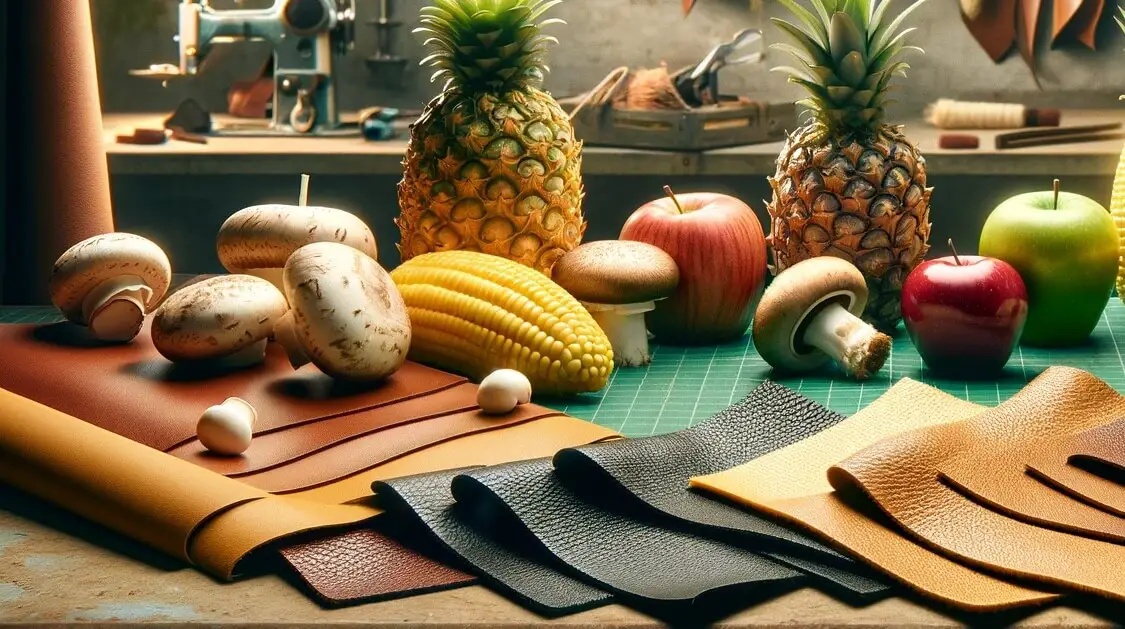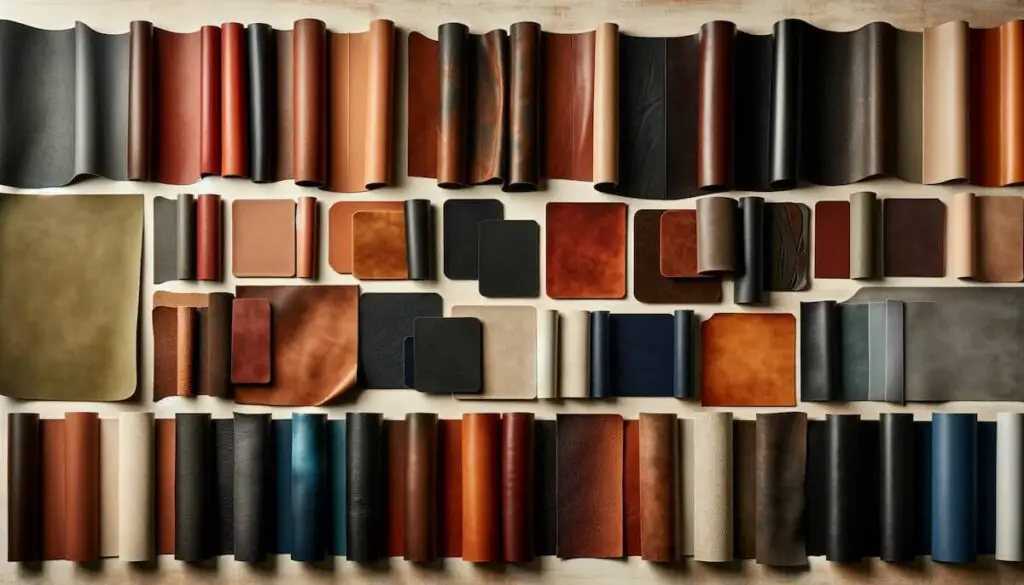Your cart is currently empty!

We’re lucky to live in today’s age, where we have plenty of material alternatives, such as artificial leather.
Artificial leather, also known as synthetic leather, is a material that mimics the look and feel of traditional leather without animal products and features a 38.98 billion USD global market size.
While most people who use this product do so for ethical reasons, more are switching due to the many other benefits as well.
Artificial leather is a vegan product and it is often cheaper, more durable, and eco-friendly when compared to traditional leather. However, this is not mainstream knowledge yet and many people don’t know these benefits.
Below we will explain all about artificial leather and why it is an excellent alternative to the traditional stuff.
What is Artificial Leather?
All artificial leather is designed to have the same texture, look, and feel as traditional animal leather but is made from cruelty-free sources.
Materials are often vegan-friendly, less environmentally harmful, and longer lasting.
Artificial leather has many names, including faux leather, PU leather, leatherette, imitation leather, vegan leather, and pleather.
Materials used to create artificial leather vary depending on the manufacturer. For example, some use corn, pineapple, mushroom, and other materials combined with polyurethane or PVC to create faux leather. Polyurethane (PU) and PVC is an elastic liquid plastic that can be stretched and reformed.
However, newer brands are starting to craft complete plant-based leather without adding extra materials.
The stretchy nature of polyurethane allows manufacturers to create a leather-like texture, resulting in a similar feel and look to animal skin.
With the addition of a more durable base, this produces a artificial leather that is aesthetically pleasing and sturdy.
Plus, it’s more eco-friendly and cost-efficient, leading more companies to make the switch.
How is Vegan Leather Created?
Artificial leather is a synthetic material that uses a polyurethane film to help produce that traditional texture and look of genuine leather.
The polyurethane film is then applied to a fabric as a backing, creating artificial leather. So, the exterior is made from polyurethane, while the fabric underneath is produced from various materials.
The manufacturing process requires four steps:
- Create a base fabric – Fabric is chosen
- Bond polyurethane on both sides of the base fabric
- Dye the exterior
- Texture the exterior to look like leather
Types of Plant-Based Leather

There are multiple types of artificial leathers, as they tend to change depending on the use and manufacturer.
Each kind is uniquely crafted to have certain benefits. Below is a list of the existing types of fake leather:
- Corn Leather – is made from corn waste and is often used to craft handbags and vegan shoes and vegan boots. Corn leather is biodegradable, easy to work with, and waterproof. However, it is prone to peeling over time.
- Pineapple Leather (Pinatex) – created from pineapple leaf cellulose fibers and produced by Ananas Anam. It’s 30% cheaper than traditional leather, more durable, lightweight, and exhibits decent tensile strength. However, it is not biodegradable. Designed by Dr Carmen Hijosa and Ananas Anam, it’s popular with fashion-forward companies such as Nova Milan.
- Mushroom Leather (Mycelium/Muskin) – made from mycelium, which are vegetative filaments that are fungi branches. It features high tensile strength and is tear-resistant. However, it’s just as costly as traditional leather at present. The Italian textile company Grado Zero Escape popularized mycelium and muskin.
- Apple Leather – created using apple skin. It features high durability and is water-resistant. The downside is that it’s still 50% fossil-fuel derived and isn’t biodegradable. AppleSkin and Good Guys Don’t Wear Leather craft signature plant-based apple leathers.
- Cactus Leather – produced using mature leaves of the prickly-pear cactus. Superior water resistance and biodegradable. The main downside is that it’s costly and there’s limited availability. The Mexican brand Desserto popularized and pioneered its use.
- Cork Leather – made from cork oak tree bark. It’s one of the most tough and durable plant-based leathers. However, it’s more expensive than traditional leather and is often paired with polyester, which is less eco-friendly.
- Coconut Leather – created from coconut waste. It’s water-resistant, breathable, biodegradable, and sturdy. However, it’s more costly than other plant-based leathers and is more porous, which means it can get dirty more easily. Malaiv is a Kerala-based eco-fashion company working to develop sustainable products using coconut leather and more!
Which Artificial Leather is the Most Durable?
Cork is the most durable in terms of plant-based leather. Cork is crafted using oak bark and is long-lasting, durable leather.
Many companies claim their cork leather products can last for up to twenty years or more. In fact, cork products are used by NASA due to their longevity.
Leather alternatives are made using polyurethane (PU), and PVC which are some of the most durable on the market.
Not all plant-based leather alternatives use polyurethane because it’s a synthetic material and isn’t always made sustainably. However, polyurethane is extremely durable and can last upwards of seven years.
Of course, the longevity of the leather will highly depend on individual use. Some artificial leathers will last a lifetime if properly cared for. Otherwise, some may only last a minimum of five years.
A few standout factors to look for online when buying artificial leather are:
- Waterproof
- Abrasion resistant
- Longevity
- Quality of materials used
Will Vegan Leather Become the Norm?
It’s hard to say if faux or traditional leather will become the norm. In a good sign markets do appear to be switching to cruelty-free products, but right now most faux leather may not be the best option from a sustainability perspective.
Most artificial leather uses polyurethane, which isn’t environmentally friendly. It takes years to break down and is a plastic product not found in nature, unlike traditional leather, which is biodegradable unless tanned.
Most consumer leathers are tanned though and thats why the question of which leather is more environmentally friendly is a hard one to answer.
Although I would argue that the environmental impacts of animal leather production include significant carbon emissions from livestock farming, extensive water usage, and land consumption, contributing to deforestation and habitat loss.
The tanning process often involves toxic chemicals, leading to pollution and potential harm to ecosystems. And, leather’s reliance on the meat industry links it to the broader environmental issues associated with intensive animal farming.
These factors combine to give animal leather production a considerable ecological footprint.
The global synthetic leather market size was 38.98 billion in 2023.
In the coming years, it’s estimated to grow by a compound annual growth rate (CAGR) of 7.87% from 2024 to 2030. While this isn’t a huge increase, it shows a market and demand for traditional leather alternatives.
Conversely, vegan and bio-based leather is expected to expand by nearly 47.5% CAGR between 2021 and 2027. That IS huge!
So, we can conclude that while there is a market for artificial leather, the bio-degradable vegan options are the ones that will become higher in demand.
Where Can You Get Artificial Leather
The best way to get your hands on artificial leather is by staying current with new plant-based and faux leather manufacturers.
Many companies are taking it into their own hands to create new artificial leather products, and you’ll need to be first in line for production.
An excellent place to find upcoming and current faux leather products is through VentureRadar and ThomasNet. These sites provide a list of recent projects and are suitable for manufacturers.
Other good places to stay updated with plant-based and vegan leathers are Plant Based News and the Vegconomist.
As a consumer, your best bet is using AlternativeLeathers. They have various artificial leathers ranging from Desserto Cactus Leather to Vegea Grape Leather. These are excellent quality and are the same leathers you’d find major companies using.
Exciting Synthetic Leather Projects
More and more companies are switching to sustainable leather, particularly a few well-known brands.
For example, you might have seen the ad for Mylo shoes while watching your favorite YouTuber. Adidas has collaborated with Mylo to create a plant-based leather shoe made from mushroom-based material.
Hermes is known for its exotic skin and traditional leather handbags. However, they are creating a Victoria bag that uses mushroom-derived leather alternatives from MycoWorks. The company has a handful of celebrity backers, including Natalie Portman, John Legend, and more.
Even accessory companies such as OtterBox are adapting plant-based leathers. The company just announced a line of sustainable cactus leather cases for the iPhone 15 and Apple Watch. The series is the Symmetry Series Cactus Leather Cases.
Besides fashion, even the automotive industry is joining efforts for more cruelty-free materials. In fact, NFW and Sage Automotive Interiors are other companies that have implemented biodegradable plant-based leather interiors.
Plant-Based Leather Internationally
It’s not just the United States that is turning to leather alternatives. Other countries around the world have started plant-based leather production.
Some of the other countries leading the way include Canada, Mexico, Taiwan, Japan, and the UK.
For example, the UK’s projected synthetic leather market is expected to have a CAGR of 7.9% between 2023 and 2030.
This is similar to other countries that are switching to leather alternatives. In fact, Mexico even saw an estimated 1.74% CAGR growth for 2024-2028, just in their footwear section.
As more brands adopt plant-based and artificial leather, production numbers will rise.
Globally, the market has a projected growth of 7.87% CAGR from 2024 to 2030. We just need more countries to start adapting artificial leather, and hopefully they will once they see how accessible and durable the alternatives are.
FAQ
Artificial leather offers environmental benefits by reducing reliance on animal farming and associated emissions, and it provides versatile, cost-effective, and cruelty-free alternatives to animal leather.
Currently, the strongest artificial leather is PU or polyurethane leather. However, popular plant-based leathers such as cork, coconut, and more are becoming more mainstream and have similar durability.
Artificial leather is made using polyurethane and from artificial material similar to plastic. On the other hand, faux leather features a fabric base such as polyester.
Resources
- https://www.americanchemistry.com/industry-groups/center-for-the-polyurethanes-industry-cpi/applications-benefits/polyurethane-applications#:~:text=Polyurethanes%20are%20commonly%20used%20in,is%20in%20short%2Dterm%20implants.
- https://en.wikipedia.org/wiki/Plant-based_leather
- https://www.corkor.com/blogs/corkor/how-durable-is-cork-fabric#:~:text=Cork%20wallets%20are%20very%20sturdy,to%20material%20even%20for%20NASA.
- https://www.grandviewresearch.com/industry-analysis/synthetic-leather-market#:~:text=Synthetic%20Leather%20Market%20Size%20%26%20Trends,7.87%25%20from%202024%20to%202030.
- https://vegconomist.com/category/fashion-design-and-beauty/leather-alternatives/
- https://www.ventureradar.com/keyword/synthetic%20leather
- https://www.thomasnet.com/products/synthetic-imitation-artificial-leather-95976650-1.html
- https://www.linkedin.com/pulse/uk-synthetic-leather-market-size-growth-se8jf/
- https://www.marketsandmarkets.com/Market-Reports/plant-based-leather-market-215444895.html#:~:text=Top%20Key%20Players%20in%20Plant,and%20PEEL%20Lab%20(Japan).

Leave a Reply